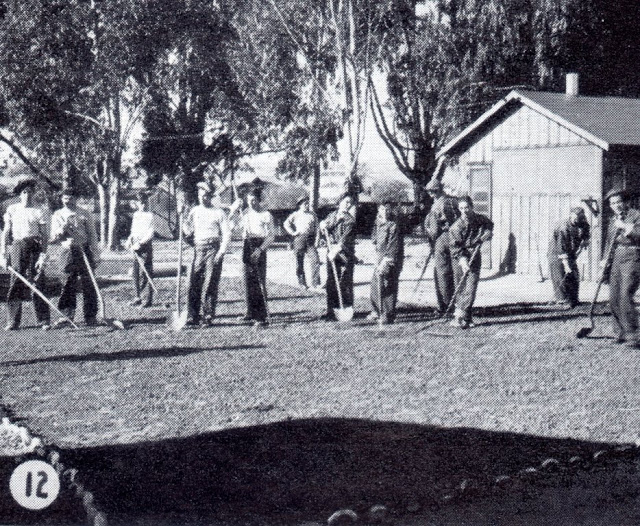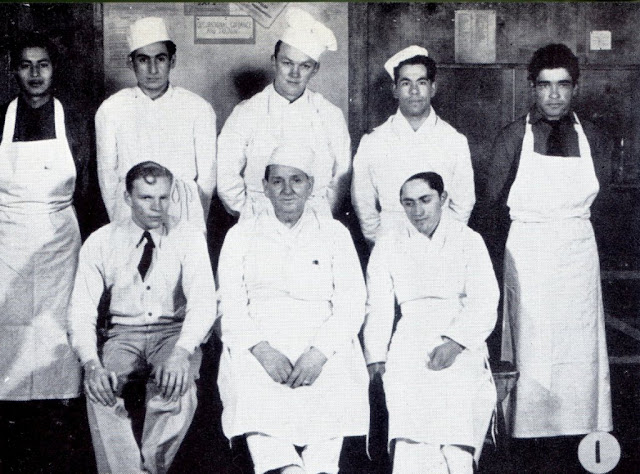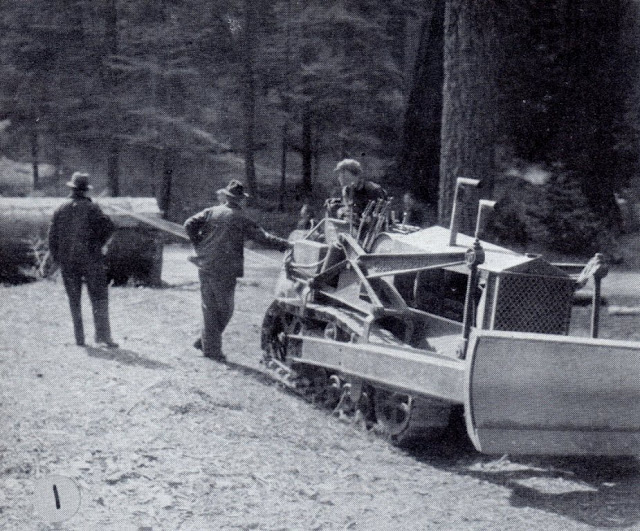Above: The cover of a 1945 booklet published by the American Museum of Natural History in Manhattan. The Hayden Planetarium was built in 1934-1935 and was financed by a $157,000 gift from businessman Charles Hayden and a $650,000 loan from the New Deal-enhanced Reconstruction Finance Corporation (RFC) (see the Living New Deal's summary of the RFC). It was demolished in 1997 (a little more on that below). Image scanned from a personal copy, and used here for educational and non-commercial purposes.

Above: A postcard showing the Hayden Planetarium. The back of the postcard is credited: "A 'Colourpicture' Publication, Boston 15, Mass., U.S.A., Published By Herbco Card Co., New York, N.Y." Image scanned from a personal copy, and used here for educational and non-commercial purposes.

Above: A cutaway of the Hayden Planetarium, from a 1937 brochure. The numbers you see correspond to descriptions of the building. For example, for number 8 we learn that the planetarium's dome "is a series of concentric hemispheres. Outermost is a shell of copper; next a shell of concrete; then one of sound-deadening cork; then one of wood; and, finally, the inside is lined with strips of perforated stainless steel." Image scanned from a personal copy and used here for educational and non-commercial purposes.

Above: This is a black & white photo of a color mural, painted by Charles R. Knight, for the Hayden Planetarium, ca. 1934-1935. The mural was funded by the Reconstruction Finance Corporation. Charles R. Knight also created New Deal artwork at the National Zoo in Washington, DC. Image from a 1937 Hayden Planetarium brochure, scanned from a personal copy, and used here for educational and non-commercial purposes.

Above: An accompanying mural panel, also by Charles Knight, depicting the Thunder Bird. Image from the 1945 Hayden Planetarium booklet (see the first photo and caption of this blog post), scanned from a personal copy, and used here for educational and non-commercial purposes.

Above: Another mural panel by Knight. Image from the 1945 Hayden Planetarium booklet (see the first photo and caption of this blog post), scanned from a personal copy, and used here for educational and non-commercial purposes.

Above: The description for this photograph reads, "Assistant Curator Marian Lockwood with group of children in the Copernican Planetarium, Hayden Planetarium, 1940." The Copernican Planetarium--also known as the Hall of the Sun--was one of several rooms in the Hayden Planetarium (it was not the main, domed planetarium room). Photo from the American Museum of Natural History digital collection (https://images.library.amnh.org/digital/index.php/items/show/45949), used here for educational and non-commercial purposes.
Above: The Hayden Planetarium's Zeiss Projector, a sophisticated instrument used to put on shows in the planetarium's main, domed viewing room. Image from the 1945 Hayden Planetarium booklet (see the first photo and caption of this blog post), scanned from a personal copy, and used here for educational and non-commercial purposes.

Above: "Adventure with Stars," an astronomy kit for children, with a star scope, star finder, sky map and more. This 1958 kit was a joint effort by Thomas D. Nicholson of the Hayden Planetarium, Alfred D. Beck of the New York City Board of Education, Capitol Publishing Co., Inc., and Simon & Schuster, Inc. And it makes one wonder... what influence did the New Deal & Charles Hayden-financed planetarium have on children? How many visited the planetarium, or received astronomy kits or publications from the planetarium, between 1935 and 1997, and were inspired to become astronomers, work at universities, observatories, or perhaps even NASA? Image above scanned from a personal copy, and used here for educational and non-commercial purposes.

Above: A closer view of a section of the astronomy kit box - classic mid-century graphics, making one yearn for the freedom and adventure of childhood!

Above: An audience at the Hayden Planetarium, ca. 1935-1937. Image from a 1937 Hayden Planetarium brochure, scanned from a personal copy, and used here for educational and non-commercial purposes.

Above: For over 60 years, the Charles Hayden and New Deal-financed Hayden Planetarium put on shows for throngs of visitors. Above is part of a 1988 Hayden Planetarium program, highlighting some of its presentations. Note the narration by "Star Trek's Mark Lenard" (Lenard played Spock's father) and James Earl Jones (the voice of Star Wars' Darth Vader). The original Hayden Planetarium was demolished in 1997 to make room for a new planetarium. Image scanned from personal copy, used here for educational and non-commercial purposes.

Above: Not only did the New Deal provide financing for the American Museum of Natural History's Hayden Planetarium, it also provided WPA labor. From 1935 to 1941, about 250 WPA workers assisted the museum in a jaw-dropping array of work. For the Hayden Planetarium and Astronomy Department specifically, WPA workers created models of Mars and the Earth's moon (above); translated scientific material from other languages; helped manage the Junior Astronomy Club; helped improve planetarium equipment; provided research and clerical assistance; and much more (information from the museum's annual reports, 1937-1941). The photo above is from the article, "Bread and Circuses and Other Things: $9,000,000,000 in Work Relief," LIFE, February 28, 1938, p.45; photo used here for educational and non-commercial purposes.
Above: From the Burlington Daily News (Burlington, Vermont), November 7, 1940, p. 11. The WPA participated in the development of this Hayden Planetarium radio show, as well as its radio show, "Men Behind the Stars." Image courtesy of newspapers.com, used here for educational and non-commercial purposes.

Above: Part of a story from the Chicago Tribune, June 2, 1940, p. 32. There is an interesting biography of Maude Bennot at, "Meet Maude Bennot: The Woman Behind the Adler" (Adler Planetarium, March 29, 2019). In its 1938 annual report, the American Museum of Natural History describes the radio show in the article above: "'Exploring Space,' a series of weekly programs on popular astronomy, in cooperation with the Planetarium and the W. P. A. radio organization... In November and December [of 1938] this program, as "Men Behind the Stars," was continued with the Columbia Broadcasting System [CBS] Department of Education cooperating with the Planetarium, and with the help of various actors of the W. P. A. radio organization." Image from newspapers.com, used here for educational and non-commercial purposes.

Above: From The Times (Shreveport, Louisiana), January 6, 1939, p. 6. The WPA-assisted radio program "Men Behind the Stars" also featured women behind the stars, such as Carolina Lucretia Herschel (1750-1848), a scientist who discovered several comets. Image courtesy of newspapers.com, used here for educational and non-commercial purposes.

Above: Part of a story from the Burlington Daily News (Burlington, Vermont), May 9, 1940, p. 9, showing the WPA-assisted "Men Behind the Stars" receiving praise from the Radio Committee of the American Association of University Women. Image courtesy of newspapers.com, used here for educational and non-commercial purposes.

Above: The shows "Exploring Space" and "Men Behind the Stars" seem to have run from 1937 to mid-1943. This is a partial radio program schedule for February 19, 1943 (from the February 13 edition of the Press and Sun-Bulletin (Binghamton, New York)), showing "Exploring Space" (column 3, row 5). You're likely to be familiar with, or at least heard of, some of the other programs listed, for example, "Ma Perkins," "Young Dr. Malone," "Pepper Young," and "Superman." Image courtesy of newspapers.com, used here for educational and non-commercial purposes.

Above: The New Deal & Charles Hayden-financed Hayden Planetarium is a spectacular piece of science history. Among its many achievements: It created more opportunities for women scientists to shine. According to her Wikipedia page, Astronomer and Anthropologist Dorothy A. Bennett (1909-1999) delivered over 1,000 lectures while assistant curator at the Hayden Planetarium, helped create the immensely popular (and still running) Little Golden Books publication, and in the 1950s/60s was the senior anthropologist at the Lowie Museum of Anthropology (now called the Phoebe A. Hearst Museum of Anthropology), University of California, Berkeley. Photo above from: The American Museum of Natural History, The Hayden Planetarium, New York: 1937. Scanned from a personal copy and used here for educational and non-commercial purposes.






















































